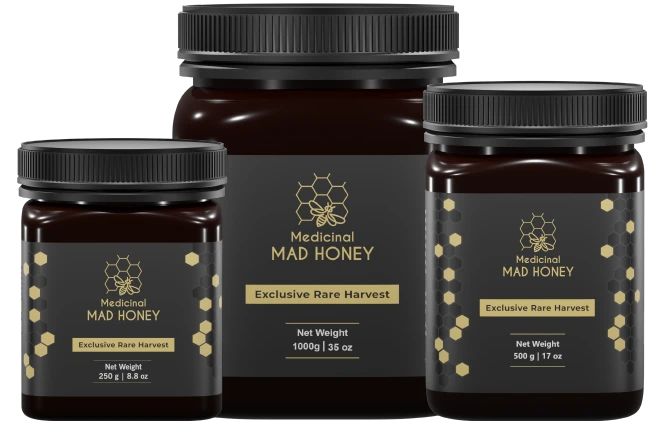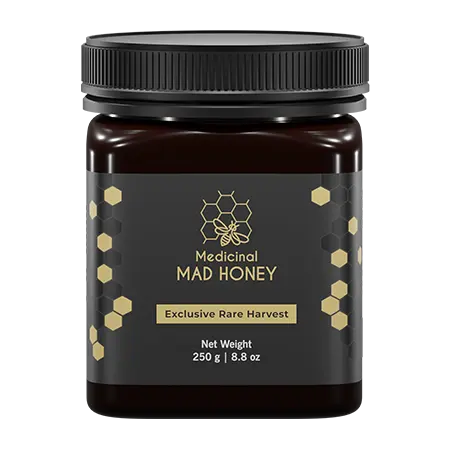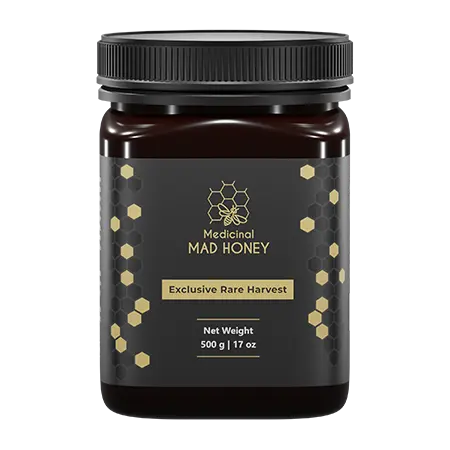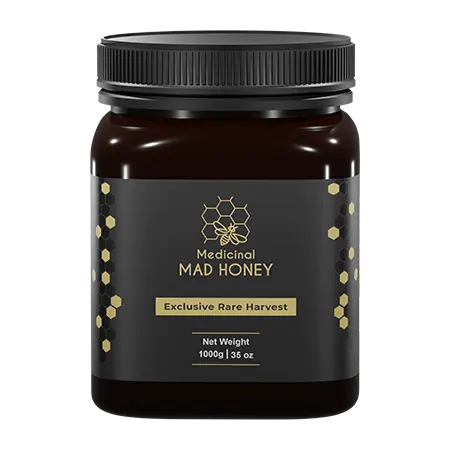Since the Himalayas are the origin of mad honey, the red mad honey and the Himalayas have an inseparable connection and a shared love.
In recent times, mad honey has transcended its traditional Himalayan origins, capturing the curiosity of travelers and adventurers in search of unique and unconventional experiences.
Origin of Mad Honey
When the world’s largest species of honeybees collect the honey, they collect it from the nectar of special kinds of rhododendron. And these special kinds of rhododendron are only found in the Himalayas of Nepal.
Mad honey is found in different parts of the world, but it’s always linked to the Himalayan region. The varied landscape and abundant biodiversity of the Himalayas create a perfect home for the rhododendron plants that produce the nectar used in making mad honey.
The high altitude, weather, and surroundings in the Himalayas support the growth of rhododendron plants that make nectar.
The mountains and remote villages in the Himalayas have also played a role in keeping the traditional honey collection methods alive, ensuring that mad honey production lives on!
Mad honey holds a dear place in the Himalayan communities. For centuries, these communities have celebrated the psychoactive and medicinal properties of mad honey. And they have tried its magical properties themselves, so they also vouch for the wonders it can do for health.
Mad Honey in Himalayan Culture
In some cultures, mad honey has been used in traditional rituals and religious ceremonies and is believed to make you more aligned with yourself. Basically, they also find that mad honey is an impeccable fluid to grow your spiritual health.
Consumed in controlled quantities, the locals say that it facilitates transcendent experiences and enhances meditation, enabling practitioners to attain deeper levels of awareness and spiritual insight.
In some Himalayan cultures, mad honey is offered as an offering to deities, symbolizing a connection between the natural world and the realm of the divine. They believe that Its consumption during religious festivals and rites promotes a profound sense of unity with the universe.
Mad Honey Usage in the Himalayas
The consumption of mad honey also has a link to traditional healing practices. In certain Himalayan cultures, honey is considered to have therapeutic qualities, such as treating gastrointestinal issues and respiratory ailments.
Furthermore, mad honey has also found its way into culinary practices, adding a unique flavor to dishes and beverages. The distinctive taste of mad honey, along with its potential effects, makes it the most sought-after condiment in cooking.
In recent times, the growing interest in natural remedies, cultural heritage, and unique culinary experiences has sparked renewed attention toward mad honey.
Sustainable Honey Harvesting
The honey hunters from the Gurung community reside in the mountain region of Nepal. They carry their traditional honey hunting knowledge, passed down over generations, graciously. Because they aim to balance mad honey production with cautiously preserving the ecosystem.
These honey hunters have a strong determination to avoid excessive harvesting from a single area and embrace sustainability. Also, they are well-known for the rhododendron flowering cycles, so they can collect the best of the best mad honey.
They use gentle extraction techniques that minimize disturbance to hives and nearby plants. This sustainable approach not only ensures a continuous supply of mad honey but also protects the delicate Himalayan ecosystem for generations to come.
Dangerous Honey Harvesting
Mad honey hunters set out on daring journeys that lead them to vertigo-inducing cliffs where the giant honey bees reside. Armed with basic ropes, handmade ladders, and unwavering determination, these courageous individuals go on to collect the mad honey.
Upon their arrival, they are welcomed with stinging bites from the honeybees, which they try to ignore. Hunters often employ smoke or other natural remedies to calm the bees and temporarily ward off their attacks.
Even with these measures, the risk of multiple stings and potential allergic reactions is a constant threat.
The climb itself is a daunting challenge. Hunters must navigate cautiously along narrow ledges, rocky formations, and steep slopes. Although they constantly worry about any misstep, they don’t stop there.
The unpredictable and rapidly changing weather conditions of mountainous regions add an additional layer of danger to the already difficult pursuit of mad honey.
What may start as a routine hunt under clear skies can quickly transform into a life-threatening test as weather patterns shift with little warning.
Thick fog, sudden rainstorms, and changing temperatures can turn a relatively straightforward expedition into a fight for survival.
How is Mad Honey Different?
If you ever think about how much honey is different from its counterparts, you might say, “After all, it’s just honey; what’s the hype?”
Well, fasten your seatbelt! Mad honey is way more powerful than regular honey. It has double the effect of what usual honey stimulates.
Rhododendron flowers produce nectar as a means of attracting pollinators such as bees. The nectar of these flowers contains trace amounts of grayanotoxins, which the bees collect and use to create honey.
What sets these particular flowers apart is the presence of grayanotoxins, a group of naturally occurring neurotoxins that can induce psychoactive and physiological effects when consumed in sufficient quantities.
The presence of grayanotoxins can relax your chattering mind, and give you a good, chilling break. It helps induce a calming night’s sleep. Not only that, but it also makes your day alive and kicking with its energy-boosting properties.
In any dull moment, only a tablespoon of mad honey in plain warm water can give you a burst of energy to make your day productive.
If you think regular honey is just too sweet for you, you can always opt for the taste of mad honey. Because it is not super sweet, it has a complex flavor of bitterness, smokiness, savory, and sweetness.
To learn more about the differences between regular honey and mad honey, you can also check: Mad Honey vs. Raw Honey: Are there any differences?
Bottom Line
As ancient traditions meet modern exploration and curiosity, the importance of mad honey in Himalayan communities keeps evolving. This exploration leads to a greater understanding of the intricate connection between nature and culture.
You cannot mention mad honey without mentioning the beautiful landscapes of the Himalayas. It won’t be wrong to say that the unusual potency of mad honey comes from the unique climate of the mountains.








1 thought on “Mad Honey and the Himalayan Connection: What Sets It Apart”
I just like the helpful information you provide in your articles